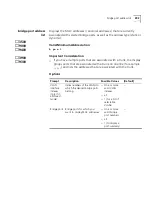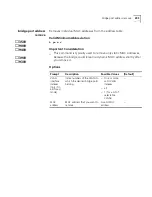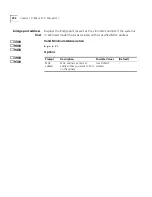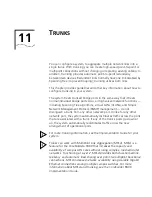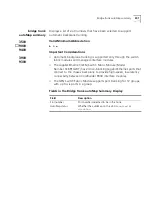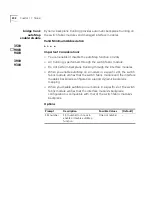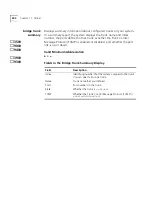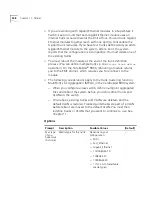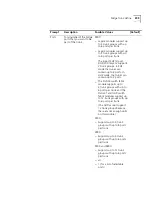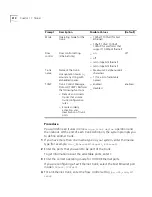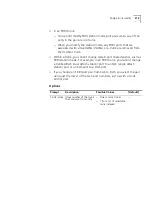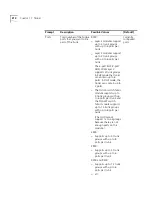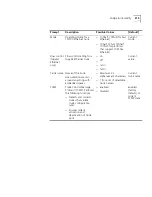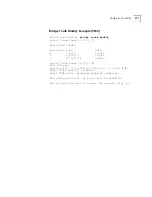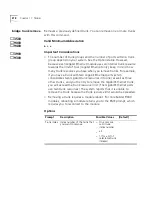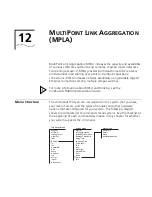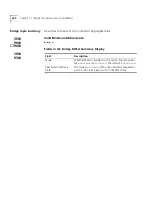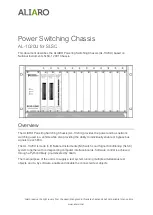
bridge trunk define
307
✓
3500
✓
9000
✓
9400
✓
3900
✓
9300
bridge trunk define
Defines one or more trunks on the system. When you define a trunk, you
specify ports and characteristics for the trunk.
Valid Minimum Abbreviation
b t def
Important Considerations
■
If you have more than one media type on your system (for example,
Fiber Distributed Data Interface (FDDI), Fast Ethernet, and Gigabit
Ethernet), you are prompted for a media type before you are
prompted for the trunk information.
■
All links to be trunked must be homogeneous. For example, you
cannot mix Fast Ethernet and Gigabit Ethernet links in a trunk.
■
If you have already defined other trunks on your system, you cannot
select ports that are part of an existing trunk.
■
In general, create trunks before you define your virtual LANs (VLANs).
If you create a trunk whose ports are part of existing VLANs, the VLAN
bridge port configuration changes. For example, if you have the
default VLAN as well as IP VLANs and you then define a trunk with
ports in one of the IP VLANs, the system removes those ports from
that VLAN and places them in the default VLAN. You must modify the
VLAN and add the new bridge ports to the appropriate VLAN. This
situation does not apply if you have only the default VLAN (all ports
are part of the default VLAN).
■
When you define a VLAN to include trunk ports, specify the anchor
port (lowest-numbered port) that is associated with the trunk.
■
Do not use Gigabit Ethernet (GEN) Interface modules (such as the
2-port 1000BASE-SX Gigabit Ethernet (GEN) Interface Module) when
defining trunks.
■
Enter
?
to see the port summary (for example, to indicate whether
there are ports associated with FDDI Dual Attach Station (DAS) pairs),
and then enter the appropriate port numbers. To specify an FDDI DAS
pair, specify the lowest-numbered port in the DAS pair.
■
The number of trunk groups and the number of ports within a trunk
group depend on your system. See the Options table.
The 3CB9FG24T switch fabric module supports up to 12 trunk groups
on the CoreBuilder 9000.
Summary of Contents for CoreBuilder 9000
Page 18: ......
Page 26: ...26 ABOUT THIS GUIDE ...
Page 27: ...I GETTING STARTED Chapter 1 Administration Overview Chapter 2 Command Summary ...
Page 28: ......
Page 64: ...64 CHAPTER 2 COMMAND SUMMARY ...
Page 65: ...II SYSTEM LEVEL FUNCTIONS Chapter 3 System Environment Chapter 4 Module Environment ...
Page 66: ......
Page 148: ......
Page 202: ......
Page 248: ...248 CHAPTER 8 FIBER DISTRIBUTED DATA INTERFACE FDDI ...
Page 250: ......
Page 320: ...320 CHAPTER 11 TRUNKS ...
Page 368: ...368 CHAPTER 14 VIRTUAL LANS VLANS ...
Page 394: ......
Page 502: ...502 CHAPTER 17 VIRTUAL ROUTER REDUNDANCY VRRP ...
Page 604: ...604 CHAPTER 19 OPEN SHORTEST PATH FIRST OSPF ...
Page 660: ...660 CHAPTER 20 IPX ...
Page 687: ...VII TRAFFIC POLICY Chapter 22 Quality of Service QoS and RSVP ...
Page 688: ......
Page 744: ...744 CHAPTER 22 QUALITY OF SERVICE QOS AND RSVP ...
Page 745: ...VIII MONITORING Chapter 23 Event Log Chapter 24 Roving Analysis ...
Page 746: ......
Page 754: ...754 CHAPTER 23 EVENT LOG ...
Page 764: ...764 CHAPTER 24 ROVING ANALYSIS ...
Page 765: ...IX REFERENCE Appendix A Technical Support ...
Page 766: ......
Page 772: ...772 APPENDIX A TECHNICAL SUPPORT ...
Page 784: ......

